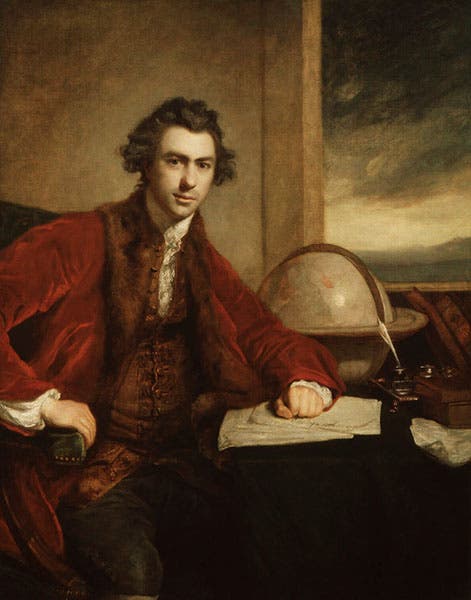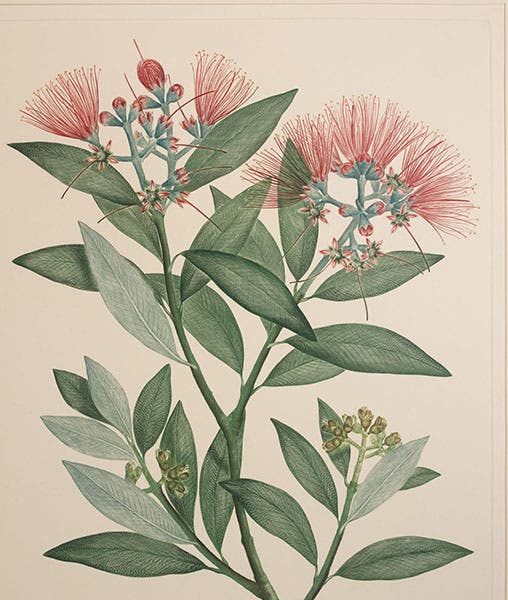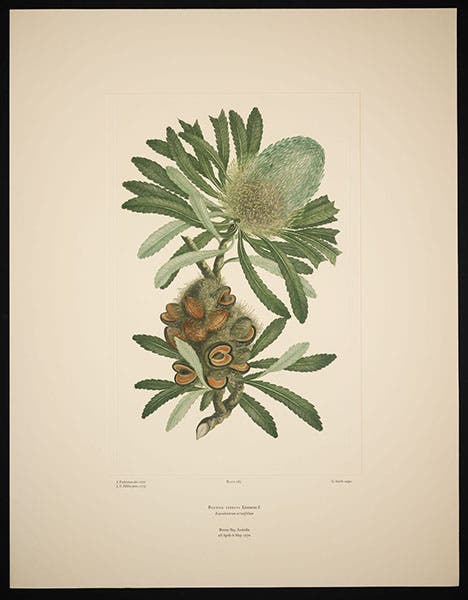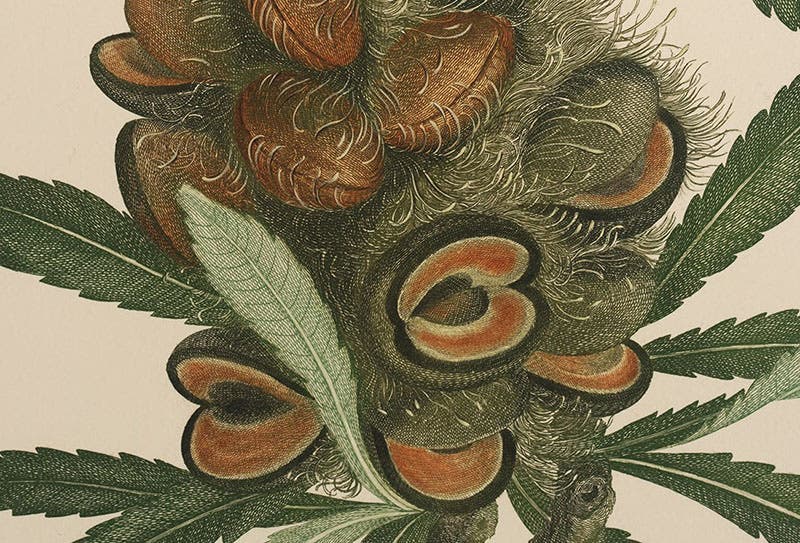Scientist of the Day - Joseph Banks
Joseph Banks, an English botanist, explorer, and scientific impresario, died June 19, 1820, at the age of 77. Banks is best remembered for being the major force behind the first around-the-world voyage of James Cook, 1768-71, for the purpose of observing the transit of Venus in 1769, and for accompanying Cook as botanist, along with several other naturalists and artists that he chose and whose salaries he paid. I wrote one post on Banks 8 years ago, on his birthday (Feb. 13), and for some reason I chose to write about his trip to the Scottish Hebrides and to Iceland in 1772, undertaken when he decided to pull out of Cook's second voyage because of disagreements about his role on the upcoming expedition. Today we are going to return to the first voyage, but once again, we are going to sidestep the adventure itself and discuss instead a publication that Banks contemplated after the voyage was completed, and he had returned home.
Banks and his fellow botanists (Daniel Solander and Herman Spöring) collected a massive number of plant specimens, almost entirely species unknown to English botanists, and he brought back an extensive herbarium of dried plants. As these plants were collected, he had his principal artist, Sydney Parkinson, draw them. Because he had so much material to deal with, Parkinson produced incomplete sketches, showing perhaps a leaf and a flower and the structural arrangement of the plant. For some of these, he was able to produce more complete watercolors onboard ship, but most were left incomplete, since Parkinson died in 1771, on the voyage home.
When Banks was back in London, he had the idea of publishing a Florilegium of the plants of Australia, New Zealand, South Africa, Tahiti, and all the other foreign lands visited by Cook’s Endeavour. He commissioned a number of artists to complete Parkinson's sketches, and a host of engravers to turn the finished watercolors into copper plates for printing. He and his illustrating team worked on this project from 1771 to 1784, when the last copper plate was engraved, 738 in all. It is thought that his intent was to have the plates printed in color, à la poupée, where the color is applied directly to the plates, so they are actually printed in color (the customary process was to print the plates with black ink and add the color by hand to the printed sheet).
For whatever reason, Banks put off the actual printing, and then, as he took on more and more projects on behalf of the Royal Society of London (including its Presidency), the Florilegium project remained on the back burner. And then, as inevitably happens, Banks was dead, and all of his collections, including the 738 copper plates, went to the British Museum. The plates were stored in a cupboard, and forgotten, for 160 years. Their rediscovery was a momentous event, and it was decided, almost immediately, to print them at last and complete Banks’ visionary project. The British Museum took the initiative and collaborated with a printer, Alecto Historical Editions, to print the plates, and it was decided to employ the laborious à la poupée process. Since this is such a time-consuming method – each plate has to be individually recolored after each print is pulled – the production was limited to 100 sets, available by subscription for the tidy sum of $100,000 each. The printing took ten years. 113 sets were eventually produced, of which only 100 would be sold. You can learn more about the project on the Alecto/Banks’ Florilegium webpage.
We have a copy of the Banks Florilegium, as it is called, in our vault. In fact, it takes up a large chunk of our vault, since the 743 prints (including 5 supplemental prints) are stored in 34 clam-shell boxes (Solander boxes), each one the size of a folded card table and weighing at least 60 pounds apiece. You can see what a portion of a set looks like (not ours) at our post on Solander. Our copy came to us by a round-about route. A local businessman bought a subscription, as an investment, and after some of his plates were stolen (and then replaced), he asked if he could store the set (which was still slowly growing) at the Library. We would have full use, but he would retain ownership. After some financial reverses, the owner decided to sell the set, and we bought them (for considerably less than he paid – this was not a good investment, for him, although great for us).
My purpose today is to demonstrate why the à la poupée process is so extraordinary for producing prints in color. In ordinary hand-colored engravings, the black engraved outline and shading is impressed on the paper, and then a wash of color is applied to the surface. With à la poupée, the color is actually IN the lines, and the only surface colors are a few dabs where needed to highlight, say, a central spot of color in a flower. One can even produce different tones, by making the lines thicker or thinner, so they hold more or less ink, as we see on the top and bottom of leaves.
I selected two prints to reproduce here, first in their entirety, and then in close detail. The first is Metrosideros excelsa, the Pohutukawa or New Zealand Christmas tree, seen in New Zealand and drawn by Parkinson (first image). The lovely crimson flowers are just beautiful, and as we see in the details (third and fourth images). Note that there are no black outlines or shading in the flowers at all.
The other print is the most famous one in the set, since it shows Banksia serrata, the plant from Botany Bay, Australia, that was named after Banks (fifth image). In the detail of the fruits (sixth image), you can see that most of the brown is in the lines, but there are a few washes of tan that were added to each plate with a brush.
When the Banks Florilegium first came to the Library, and I was introduced to à la poupée prints, I was totally enthralled, and I hauled in my wife’s stereo-microscope to take some images at high magnification. I chose the plate of Vigna vexillata, the wild cow-pea, a lovely blue-flowered plant found in Australia, because I loved the contrast of the green leaves and the soft blue flower. Even though I do not have a photo of the entire plate, I thought I would include those two photo-micrographs here, so that you can see, in the first one (seventh image), the variation in tone produced by changing the depth of cut, and in the second (eighth image), the beautiful lines of blue of the flower, enhanced by a little added blue and yellow watercolor.
We have at least two more Banks posts in us, one on the Cook voyage itself and Banks’ role in it, and another on Banks as the dominant figure in the Royal Society, and a major collector of books and exotica. Because of his fame and fortune, Banks was painted many times by portrait artists, but I think everyone prefers the portrait made by Joshua Reynolds when Banks was still young, newly returned from his circumnavigation and not yet an icon of British science. The original is in the National Portrait Gallery, London (second image).
William B. Ashworth, Jr., Consultant for the History of Science, Linda Hall Library and Associate Professor emeritus, Department of History, University of Missouri-Kansas City. Comments or corrections are welcome; please direct to ashworthw@umkc.edu.














